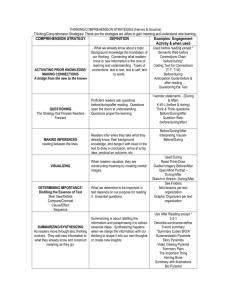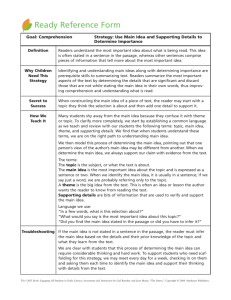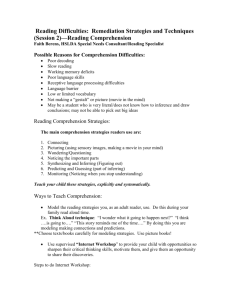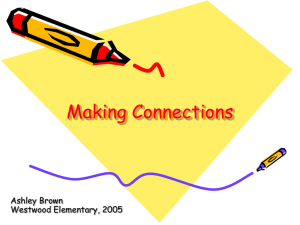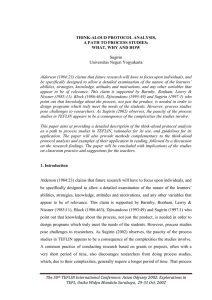POETRY A punch bowl of poetry activities (non
advertisement
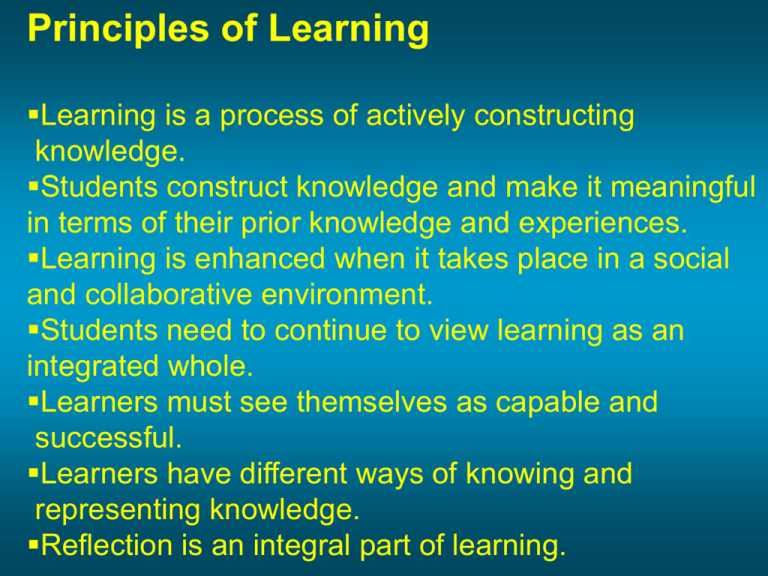
Principles of Learning Learning is a process of actively constructing knowledge. Students construct knowledge and make it meaningful in terms of their prior knowledge and experiences. Learning is enhanced when it takes place in a social and collaborative environment. Students need to continue to view learning as an integrated whole. Learners must see themselves as capable and successful. Learners have different ways of knowing and representing knowledge. Reflection is an integral part of learning. The following is the introduction to the book Weather by Seymour Simon (New York: 1993, Morrow Junior Books). Highlighted are things you could say to show students how they might try to make sense of unfamiliar words or concepts and relate them to things they already know: Earth's weather is driven by the intense heat of the sun. "is driven by": another way to say that would be "is caused by," so that must mean that the heat of the sun makes our weather happen here on earth The sun's energy travels through space in the form of visible light waves and invisible ultraviolet and infrared rays. "visible" means I can see it, "invisible" means I can't. I've heard of ultraviolet and infrared rays, but I'm not sure what they are — I think they can burn you if you don't put on sun block. About one third of the energy reaching Earth's atmosphere is reflected back into space. reflected like with a mirror? What makes it reflect back into space? The remaining two thirds is absorbed during a process called insolation (from incoming solar radiation). I've heard of "insulation" but not "insolation" — wonder how these things are different. "Insulation" helps you keep warm, sounds like "insolation" would make something warm, too. “If I had to pick the element of Reading Workshop Instruction that is the most beneficial to these adolescent struggling readers, this (Think-Aloud) is it.” (Mueller, 2001, p. 120) "Kids become better readers by reading," she says. "We allow them to choose books they want to read and give them the time to read. I believe that all kids can become readers." Think-Aloud (Beth Davey, 1983) Thinking Aloud is making thinking visible, disclosing how you read by modelling/demonstrating how you think about what you read. Voices inside the head… Narrative voice – the text itself Interacting voice – makes connections, asks questions, identifies confusions, agrees or disagrees Reciting voice – occurs when the reader only recites the words but gains no meaning Distracting voice – pulls reader away from the text and its meaning – unrelated thoughts Tovani, Cris, I Read It, but I Don't Get It: Comprehension Strategies for Adolescent Readers. Stenhouse: 2000 Think-Aloud Think-Aloud provides readers assistance in examining and developing reading behaviors.The strategy incorporates five aspects of a skilled reader’s thinking: predicting, visualizing, making connections, questioning, monitoring and self-correction. Six strategies: Making Connections Questioning Visualizing Inferring Determining Importance Synthesizing MAKING CONNECTIONS • text to self • text to text • text to world “ This remind me of … ” Making connections activates and utilizes prior knowledge. Make analogies by linking prior knowledge to new information. “ This situation is like _____." “ This is like a time . . . ” QUESTIONING: interacting with the text through a series of questions/queries. Asking questions and looking for answers before, during and after … “ What does that means?” “ I wonder what would happen if …?” “ Why did the author use that word or that point of view? ” “ What if…? ” “ What happened and why did it happen? ” “A reader with no questions might just as well abandon the book. When our students ask questions and search for answers, we know that they are monitoring comprehension and interacting with the text to construct meaning, which is exactly what we hope for in developing readers." Strategies That Work by Harvey and Goudvis : the key to understanding the picture the text has helped a reader to create (I see… I feel…) enhances meaning with mental imagery enables readers to become part of text stimulate imaginative thinking heightens engagement strengthens relationship with text Describe the picture that is forming internally. “ I can see . . . ” “ I have a picture in my mind . . .” “ … research suggests that readers who are able to visualize what they are reading – for example, characteristics of setting, events in the story, or character traits – are better able to comprehend what they read.” (Lessons in Comprehension, Frank Serafini, 2004) INFERRING: •making assumptions based on clues within the text •questioning and drawing conclusions •making predictions •reflecting •reading beyond the words. Predict by using the title, pictures, and opening sentences. “ I believe this part will be about _____. " “ From the title, I think this selection is going to be about . . . ” “ In this next part. . . ” Predictions are inferences. We base a prediction on what has been stated in the text, but we add to it an informed guess about what is to come. Mosaic of Thought, Keene & Zimmerman p. 153 Sue blew out the candles and got presents. John went running into the street without looking. We bought tickets and some popcorn. When I woke up, there were branches and leaves all over the yard. Yesterday we cleaned out our desks and took everything home. Use Fix-Up Strategies: When I get stuck I can ... Verbalize confusion by pretending lack of understanding. "This doesn't make sense to me.” “ I'm not certain what the author is suggesting." “ This seems confusing. . . ” “I am not sure how this fits. . . ” Model strategies to assist with decoding or comprehension. “ I'd better read this part again." "Perhaps if I read this section aloud, I will understand it better." "If I think about the way we talk, I may be able to read this sentence better.” “Fixing Up” Comprehension When I get stuck, or when reading bogs down, I know what to do. I can read ahead to get more meaning. I can re-read to check meaning. I can look at charts, graphs, pictures. I can think about what I already know and make a good guess… I can sound out words or look for parts of words I do understand. DETERMINING IMPORTANT IDEAS: What is the main idea of the text? “ I understand what the author is saying…” What is important to remember about this text? Synthesizing: combining what is known with new information to understand the text Now I understand … I learned … I get it now! Some activities for making synthesizing concrete include making orange juice, doing a jigsaw puzzle, and building with Legos. All are activities that involve putting assorted parts together to make a new whole, which is what synthesizing is all about. Strategies That Work, Harvey & Goudvis Comprehension of Reading may not be easy – students should be encouraged to struggle, but with strategies to call upon is aided by the teacher’s enthusiasm for what is being read – how the teacher finds the material valuable needs to be modelled – show how you construct meaning. Different materials require different strategies. T O O L S f o r T H I N K I N G a b o u t ■ Think Aloud ■ Graphic Organizers ■ Brainstorming ■ KWL (KWHL) ■ Anticipation Guide ■ Dramatic Performance ■ Probable Passage ■ Slow Down Your Thinking Post-Its ■ Coding Text (*, ?, X,BK, T-S,T-T,T-W, R) ■ Bookmarks ■ Double entry Journals ■ Sketching ■ It Says, I Say, and So… ■ Say Something ■ Mental Mapping ■ RAFT –Role-Audience-Format-Topic ■ The Last Word Best Practices Are reading strategies explicit? Are reading strategies modelled? Are there links between the reading and writing, speaking and listening, viewing and representing? Are there supports for struggling readers and writers? Are books available to students? Do students have choices? Is there quality instruction?

